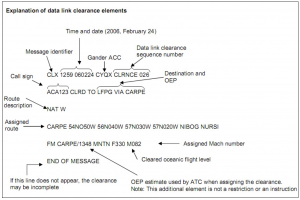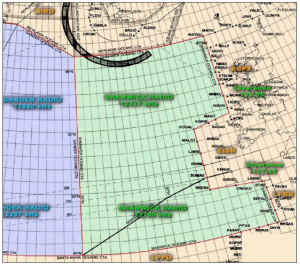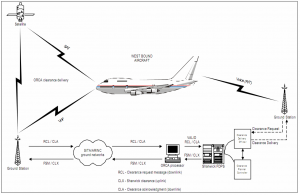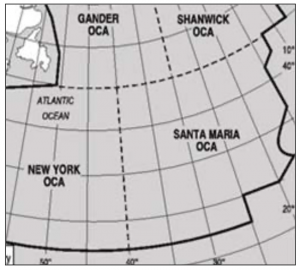48TH ANNUAL CONFERENCE, Dubrovnik, Croatia, 20-24 April 2009WP No. 90Datalink – Review Policy on Downstream ClearancesPresented by TOC |
Summary
With Downstream Clearances, a pilot can contact via data link a second controller further down his route and receive a clearance. This service is currently used by pilots to request oceanic clearances before entering North Atlantic airspace. This paper will review the IFATCA Policy on the use of Downstream Clearances considering their current implementation for oceanic clearance delivery according to the safeguards contained in the ICAO Manual of ATS Data Link Applications. A Policy update is recommended in this working paper.
Introduction
1.1 Downstream clearances are a specific additional data link that allows the pilots to exchange data link messages with more than one Air Traffic Services (ATS) unit. In 1997 IFATCA adopted Policy on downstream clearances to highlight the necessary safeguards that must be used for any implementation. These safeguards can be found in the ICAO Doc 9694 Manual of Air Traffic Services Data Link Applications.
1.2 The aim of this working paper is to review IFATCA Policy in the light of recent downstream clearances implementations, and other developments.
Discussion
2.1 Data link downstream clearances
2.1.1 Downstream Clearance (DSC) is a data link service included in the Controller-Pilot Data Link Communications (CPDLC) application. CPDLC is the electronic dialogue part of the data link implementations (besides surveillance through automatic position reports), allowing controllers and pilots to compose, send and receive text messages on ground and cockpit interfaces such as the Aircraft Communication Addressing and Reporting System (ACARS) instead of voice messages.
2.1.2 DSC is the CPDLC service that allows the pilot to request and receive an electronic clearance from a distant control unit further down along his route via a second data link, while maintaining the initial data link with the current control unit.
2.1.3 DSC is a controversial service since it allows the pilot to receive two clearances from two different controllers with a possibility that each controller does not know what the other controller is sending to the pilot. This service has not been implemented so far, except in the North Atlantic (NAT) oceanic domain to improve the transmission of oceanic clearances replacing the traditional voice request with an electronic text clearance.
2.2 Oceanic clearances voice procedure
2.2.1 Delivering oceanic clearances via voice is time and frequency consuming. To enter NAT oceanic airspace, an oceanic clearance is mandatory and must be requested from oceanic control at least 40 minutes before entering oceanic airspace.
2.2.2 Below an example of radio communications for the voice procedure between Shanwick Radio and a pilot requesting an oceanic clearance on the second radio (while remaining in contact with domestic control on the primary radio).
PILOT: “Good day Shanwick, Speedbird 123 request oceanic clearance”.
Shanwick: “Speedbird 123, Good day, go ahead”.
PILOT: “Speedbird 123 request NAT CHARLIE via 53/15 53/20 54/30 54/40 53/50 HECKK SAINT ANTHONY at Flight Level 350 and Mach .80. Estimating 53/15 at 1943 ZULU”.
Shanwick: “Speedbird 123, Cleared as filed along NAT CHARLIE to BOSTON at FL350 Mach decimal 80 cross 53/15 not before 1940 ZULU”.
PILOT: “Speedbird 123 cleared track Charlie FL350 Mach decimal 80 53/15 not before 1940 ZULU”.
Shanwick: “Speedbird 123 correct continue with domestic, bye bye”.
PILOT: “Speedbird 123, bye”.
2.2.3 The drawbacks of this voice procedure are the need for the pilot to use his second radio set while maintaining radio contact on the first set with domestic control. Besides, the oceanic controller has to answer as soon as possible and start a time consuming communication.
2.3 Oceanic clearances DSC potential
2.3.1 The benefits of a DSC oceanic clearance transmitted in text format are obvious:
- The pilots maintain only one radio contact (with domestic control) and do not need to contact oceanic control unless the DSC procedure fails or a voice negotiation is necessary.
- Upon reception of the DSC request, the oceanic controller has some time to prepare the answer.
- The oceanic clearance message elements are unambiguously transmitted and avoid tedious vocal requests and read-backs.
- The frequency occupancy is greatly reduced.
2.4 DSC implementations
2.4.1 Gander
2.4.1.1 The Gander Area Control Centre (ACC), located in Gander, Canada, provides air traffic control services over both domestic and oceanic airspace. Picture 1 represents (on the left) “CZQX Domestic” airspace and (in blue) the Gander Oceanic Control Area (OCA).

Picture 1 – Gander oceanic airspace
2.4.1.2 Controllers use the Gander Automated Air Traffic System (GAATS) display:
- in domestic airspace with radar and VHF frequencies.
- In oceanic airspace, Future Air Navigation Services (FANS) is an ACARS-based onboard data link technology that offers Automatic Dependant Surveillance – Contract (ADS-C) and Controller Pilot Data Link Communications (CPDLC).
Radio communications are either VHF close to the continent (“clearance” frequency, for instance) or HF over the ocean through flight service stations operators (“Gander Radio” HF frequencies) that collect and relay the voice communications between pilots and controllers.
2.4.1.3 Data link Oceanic Clearance Delivery (OCD) service is provided via digital VHF and satellite to ACARS equipped aircraft via network service providers ARINC and SITA since 1991.
2.4.1.4 The pilot sends a clearance request (Request oceanic Clearance (RCL)) to Gander ACC when the flight is between 90 and 30 minutes away from the oceanic entry point (or 10 minutes prior to start-up if he is departing from an airport less than 45 minutes away from the oceanic entry point). The RCL includes the same information elements as in a voice request.
2.4.1.5 Within 5 minutes, the ground system verifies that it corresponds to an existing flight plan and acknowledges the reception of the request with a datalink message indicating: “if no clearance received within 30 minutes of oceanic entry point revert to voice procedures end of message” (and if this acknowledgement is not received within 5 minutes, the crew should obviously request the clearance via voice).
2.4.1.6 The oceanic clearance process between Gander domestic and Gander oceanic is completely electronic: the oceanic controller receives an electronic estimate from the domestic (containing the requested flight level, Mach number and route). Based on this information, the oceanic controller develops an oceanic clearance and enters it in the GAATS which sends it electronically to the domestic controller. If a reroute has to be issued for an aircraft for the oceanic entry point, manual coordination is done along with the same electronic process. Picture 2 gives an example of a data link oceanic clearance.

Picture 2 – Example of data link oceanic clearance
2.4.1.7 The flight level contained in the data link oceanic clearance is the “cleared oceanic flight level” (used in case of lost communications procedures) and the aircraft is supposed to reach this level before entering the oceanic area. The current Gander domestic controller has access to the oceanic clearance and is responsible for providing a clearance to reach this level.
2.4.1.8 When the oceanic clearance is received and possibly printed, the pilot sends a Clearance Acknowledgement (CLA) containing a complete read-back of the elements (he can also be requested in a remark field to read back the clearance via voice). This read-back is checked by the ground system against the issued clearance to uplink a confirmation or cancellation message.
2.4.1.9 Pilots can request an amendment to the oceanic clearance via voice within 200 NM of a Gander clearance delivery frequency station. To amend a clearance, the controller adds a line mentioning “reclearance n°[1 to 9]” and this amendment number is used for acknowledgement. Pilots must also revise via voice their oceanic entry point time by voice if the time deviation exceeds 3 minutes.
2.4.1.10 Various error messages are available in case of service unavailability, early or late request, format error, invalid callsign or flightplan, acknowledgement not received.
2.4.2 Shanwick
2.4.2.1 The Prestwick (UK) Oceanic Area Control Center (OACC) provides ATS within the Shanwick OCA. The Shanwick Automated Air Traffic System (SAATS) is very similar to Gander GAATS and uses the same ADS-C tracks and CPDLC dialogues. HF communications are provided by Shannon (Ireland) Ballygirreen Radio Station (“Shanwick Radio” callsign) operating 20 HF frequency channels.

Picture 3 – Shanwick oceanic airspace
2.4.2.2 Shanwick offers the Oceanic Route Clearance Authorisation (ORCA) service to westbound aircraft equipped with ACARS. Clearance request, transmission and acknowledgement are very similar to Gander OCD, including the procedures to revert to voice in case of negotiation request, the revision number included in the clearance text.
2.4.2.3 Picture 4 summarizes the OCD procedure. It represents on the left the satellite or digital VHF networks used by SITA and ARINC to deliver Shanwick ORCA clearances, and on the right the Ground Station relaying the radio communications that are required each time a clearance is not received or acknowledged.

Picture 4 – OCD architecture
2.4.3 Santa Maria
2.4.3.1 Operational trials of OCD in the Santa Maria (Portugal) OCA have started in September 2007. Clearance requests, read-backs and revisions follow the same procedures as in Gander and Shanwick.

Picture 5 – Santa Maria oceanic airspace
2.5 IFATCA contribution and Policy
2.5.1 In 1996, IFATCA contributed to the elaboration of the Draft ICAO Manual of Air Traffic Services Data Link Applications (which has since been adopted in 1999) and formulated in the “Downstream Clearance Service Description” section some recommendations for the use of DSC that will be described below.
2.5.2 In 1997, IFATCA adopted the ATS 3.2 “Downstream Clearances” Policy (Technical and Professional Manual page 3 2 3 2) to underline the necessity for any DSC implementation to comply with the requirements detailed in ICAO Doc 9694 Manual of Air Traffic Services Data Link Applications in order to avoid new risks associated with the introduction of the DSC second data link. The Policy reads:
| “Where Downstream Clearance capability is provided via Data Link, sufficient safeguards must be implemented in accordance with the Draft ICAO Manual of Air Traffic Services (ATS) Data Link Applications, Draft Version 0.4, dated 20 September 1996.” |
2.6 DSC issues
2.6.1 Allowing the pilot to request and receive an oceanic clearance from oceanic control while still flying in continental airspace raises some safety issues that do not exist in the voice operations context.
2.6.2 In a CPDLC environment, the aircraft is generally linked to only one ATS unit, the Current ATS Unit (C-ATSU) which provides air traffic services via voice and data link. When the pilot may need to obtain clearances and information from a second ATS unit further along the route, he initiates a second data link with this Downstream ATS Unit (D-ATSU). DSC is the only data link service providing this additional data link to a second ATS unit and offering a simultaneous connection to the C-ATSU and the D- ATSU.
2.6.3 There are safety concerns about this second link:
- The C-ATSU is not aware that the pilot is requesting and receiving a downstream clearance from the D-ATSU and the risk of contradicting clearances from C-ATSU and D-ATSU must be removed by proper coordination.
- The pilot must not mistake clearances from the C-ATSU and the D-ATSU, the risk being that if a pilot receives a DSC and mistakes it for a current C-ATSU clearance, he might comply with it immediately instead of waiting to enter the D-ATSU airspace.
2.7 ICAO Doc 9694 Manual of Air Traffic Services Data Link Applications safeguards
2.7.1 To solve these potential confusions, here is a short summary of the safeguards that have been formulated in ICAO Doc 9694 Manual of Air Traffic Services Data Link Applications.
2.7.2 “Messages received from the D-ATSU must be easily differentiated from C-ATSU messages”
When reading the clearance, the crew must have no doubt whether they have to comply with it immediately or wait to enter D-ATSU airspace.
2.7.3 “The D-ATSU ground system must have the possibility to reject a DSC request”
The pilot must know quickly that he will not receive any DSC so that he tries to contact the D-ATSU in another way without losing time.
2.7.4 “The DSC service can only be initiated by the pilot”
If the D-ATSU was able to send a DSC, there would be the risk that the crew pay not enough attention and mistakes it for a C-ATSU clearance.
2.7.5 “There can only be one DSC link”
Considering all the safety issues related to the creation of a second data link and described in the previous chapter, it is not advisable to allow a third or fourth data link that would increase the risk of misinterpretations of the various DSC and the number of coordinations between the ATSU.
2.7.6 “Procedures must prevent the pilot from executing a DSC clearance before entering D- ATSU airspace, unless proper coordination with C-ATSU”
As long as the DSC has no implications on the C-ATSU management of the flight, there is no need for him to know that the pilot is negotiating a DSC with the D-ATSU. But if the DSC level or route is different from the current flight parameters, there must be coordination between the D-ATSU and the C-ATSU so that the C-ATSU is aware of the necessary clearances he must give to the pilot in his airspace before the flight leaves it at the proper level or route required by the DSC.
The pilot must never change his flight parameters without the C-ATSU authorization!
2.7.7 “Some messages (for example, level or profile-changing clearances) are prohibited as such, unless they are concatenated with position or time constraints to avoid early compliance”
This is the most sensitive issue. ICAO Doc 9694 Manual of Air Traffic Services Data Link Applications enumerates in its Table IV-8-2 all the CPDLC message elements that are prohibited from use in isolation for DSC: vertical clearances, crossing constraints, lateral offsets, route modifications, speed changes, contact requests and the related downlink requests (vertical, route, speed changes requests).
For example, the Uplink Message (UM) element number 21 “AT (position) CLIMB TO (level)” is available for use in isolation in a DSC, but not the message element UM20 “CLIMB TO (level)” because it lacks the position constraint in the future D-ATSU airspace and may accidentally be complied with in the C-ATSU airspace. This UM20 is only available if concatenated with other elements such as in this combination: UM77 “AT (position) PROCEED DIRECT TO (position)” + UM165 “THEN” + UM20 “CLIMB TO (level)” to indicate the position in the D-ATSU airspace where the climb instruction must be followed.
2.7.8 As oceanic operations feedbacks have shown through ‘Oceanic Errors Safety Bulletins’, it is essential to compose concatenated messages with great precaution regarding the constraints, especially the use of “AT” and “BY”. An “AT” clearance specifies a position or time at which the level change is to be initiated. A “BY” clearance is a restriction, indicating a position or time at which the level change must be completed.
2.8 Implementations compliance
2.8.1 Considering the OCD implementations in Gander, Shanwick and Santa Maria of DSC, it can be verified that all these precautions have been taken into account.
2.8.2 “Messages received from the D-ATSU must be easily differentiated from C-ATSU messages”
The OCD uses Aeronautical Radio Incorporated standard 623 (ARINC 623) and European Organization for Civil Aviation Equipment Document 106A (EUROCAE ED106A) specifications, which define the ATC related text messages (Digital ATIS, Departure Clearances…) that can be generated or received by an onboard ACARS system. The same messages are exchanged in these different OCD and they clearly indicate whether it is a request, a clearance or a acknowledgement. For amendments and revisions, a revision number and an additional text line is included in the clearance message.
2.8.3 “The D-ATSU ground system must have the possibility to reject a DSC request”
The ground has the possibility to reject an OCD request automatically should the system be unserviceable, or manually if the controller wants the pilot to initiate a voice communication and negotiation.
2.8.4 “The DSC service can only be initiated by the pilot”
The OCD request can only be initiated by the pilots, reflecting the voice request procedure.
2.8.5 “There can only be one DSC link”
The pilot only initiates a data link contact with Gander if eastbound and Shannon or Santa Maria if westbound, and cannot establish more than one DSC link.
2.8.6 “Procedures must prevent the pilot from executing a DSC before entering D-ATSU airspace, unless proper coordination with C-ATSU”
Procedures exist to communicate the oceanic clearance between the OCD controller and the domestic controller currently in charge of the flight, so that the domestic controller knows which route, oceanic entry point and level he must give to the pilot in order to enter the oceanic area according to the oceanic clearance.
2.8.7 “Some messages (for example, level or profile-changing clearances) are prohibited as such, unless they are concatenated with position or time constraints to avoid early compliance”
Due to the classic voice oceanic clearances legacy, oceanic clearances have a text- based specific format that does not use the CPDLC standard message elements as described in ICAO Doc 9694 Manual of Air Traffic Services Data Link Applications. Oceanic clearances have a different presentation and use abbreviations to describe oceanic routes, levels and mach numbers in such a way that they cannot be mistaken for an immediate CPDLC clearance.
2.9 Partial clearances
2.9.1 DSC has been introduced in the NAT to cover the need for oceanic clearance delivery: a pilot cannot enter oceanic airspace without a specific oceanic clearance, and it is not delivered by the domestic controller he is in contact with.
Oceanic clearances are an example of partial and successive clearances that are delivered to pilots in several places around the world. In Europe for example pilots receive a confirmation of their flight plan route or an amended route only when entering a new Air Navigation Service Provider (ANSP) airspace. The reason is that many ANSPs do not take the responsibility to issue route clearances inside the next ANSPs airspace.
2.9.2 This partial clearance issue will become problematic for data link route clearances. If the ANSPs procedures do not change, it is likely that partial data link clearances will be sent to pilots, or provisional full route clearances appended with a clearance limit at the ANSP airspace boundary. This is a complex issue that various data link working groups developing service descriptions are confronted to.
2.9.3 In this context, it would not be wise to use DSC to request and receive the next route portion in a downstream ANSP airspace. DSC used for OCD complies with all the requirements in the ICAO Doc 9694 Manual of Air Traffic Services Data Link Applications, due to the very limited and specific nature of oceanic clearances that can hardly be confused with en route clearances. DSC used to communicate with the next ANSP controller to get the next portion of route would prove much more difficult to comply with the ICAO Doc 9694 Manual of Air Traffic Services Data Link Applications requirements. The identical nature of the en route clearances obtained from the current and the downstream controllers would lead to safety issues much more complex than for oceanic clearances.
Conclusions
3.1 DSC has only been implemented for oceanic clearance delivery in the Gander, Shanwick and Santa Maria OCD service. The risks associated with the reception of clearances from two different controllers and the other DSC issues mentioned in ICAO Doc 9694 Manual of Air Traffic Services Data Link Applications, that IFATCA contributed to, are all properly addressed in OCD.
3.2 Since no other DSC implementation has occurred and put forward operational issues that could require additional requirements to be added to ICAO Doc 9694 Manual of Air Traffic Services Data Link Applications or justify an IFATCA Policy profound revision, we only recommend a reference update in the IFATCA Policy: ICAO Doc 9694 Manual of Air Traffic Services Data Link Applications has been published in 1999 and this reference must be corrected in the IFATCA Policy.
3.3 DSC may be used for other purposes than OCD. In this case compliance with ICAO Doc 9694 Manual of Air Traffic Services Data Link Applications would be more problematic than for OCD, especially in the context of partial route clearances that data link panels and working groups will have to address. For all the potential uses of DSC, IFATCA Policy is still relevant.
Recommendations
It is recommended that;
4.1 IFATCA Policy on page 3 2 3 2 of the IFATCA Technical and Professional Manual:
Where Downstream Clearance capability is provided via Data Link, sufficient safeguards must be implemented in accordance with the Draft ICAO Manual of Air Traffic Services (ATS) Data Link Applications, Draft Version 0.4, dated 20 September 1996
is amended to read:
Where Downstream Clearance capability is provided via Data Link, sufficient safeguards must be implemented in accordance with the ICAO Doc 9694 Manual of Air Traffic Services Data Link Applications, First Edition 1999.
4.2 The use of partial route clearances via Data Link, following from a lack of harmonization between the ANSPs procedures for full route authorization and the subsequent clearance limits, is included in the TOC Work Programme.
References
‘Gander Data Link OCD Crew Procedures’ Version 18 (22nd November 2007).
‘Guidance Material for Delivery of Oceanic Clearances by ORCA (Shanwick)’ Issue 11 (18th March 2004).
‘Oceanic Clearance Delivery (OCD) in the Santa Maria Oceanic Control Area (OCA)’ Portugal AIC A004/2007.
ICAO NAT SPG ‘Oceanic Errors Safety Bulletin’ OESB Ed.2, 2006.
IFATCA Working Paper WP 115 ‘Downstream Clearance Via Datalink’ (Taipei 1997).
IFATCA Working Paper WP 81 ‘Review of Technical Policy’ (Toulouse 1998).
ICAO Doc 9694 Manual of Air Traffic Services Data Link Applications (First Edition 1999).


